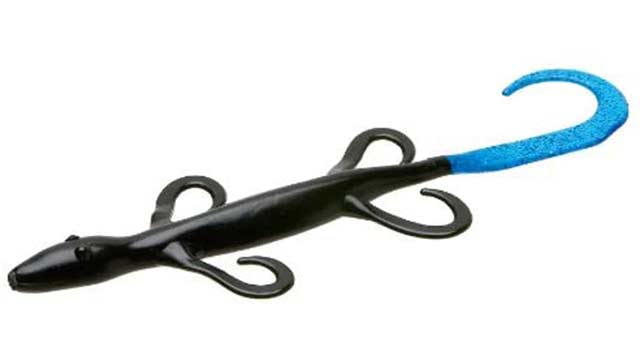During the spring, bass are very protective and aggressive. They hate it when intruders invade their territory. Soft-plastic lizards are often an over-looked lure my many anglers but are a great lure for targeting bass this time of year.
What Are Soft-Plastic Lizards?
If you’re unaware of what they are, soft-plastic lizards are a type of creature bait that look very similar to real lizards. Their lifelike legs and tail flutter through the water to draw the attention of bass. These awesome soft-plastic lures are especially great during the spring when bass are bedding.
An artificial lizard was one of the first lures I used when I began bass fishing as a kid. I used to walk ponds in South Florida with just a pack of soft-plastic lizards and catch lots of bass. It was a very productive bait and would catch bass nearly everywhere I fished. I don’t use it quite as much today, but still utilize a lizard some when bass are spawning and on their beds.

ZOOM Lizard (6 inch)
When it comes to the best brand of these awesome soft plastics, the ZOOM Lizard stands out. The ZOOM lizard is by far my favorite soft-plastic lizard on the market. It looks super lifelike, has a durable body so it doesn’t tear too easily, and comes in a variety of colors and sizes.
Top 3 Soft-Plastic Lizards
| Rank | Picture | Name | Where to Buy |
|---|---|---|---|
| 1 |  | ZOOM Lizard | See it on Amazon |
| 2 |  | Yum Lizard | See it on Amazon |
| 3 |  | Berkley PowerBait Power Lizard | See it on Amazon |
The ZOOM Lizard is my preferred soft-plastic lizard. It has a durable body and doesn’t rip easily. Its legs also give off great action and flare when brought through the water.
However, both the Yum Lizard and Berkley PowerBait Lizard are also productive baits. The Yum lizard is the most inexpensive of the three options. And the Powerbait lizard is made with a supercharged scent to attract fish, designed to attract more fish.
Each of these baits has unique action produced by their legs and tail and are reliable back-ups to the ZOOM lizard.
How to rig a soft-plastic lizard for bass?
I prefer to rig a soft-plastic lizard one of four ways:
- Texas Rigged with a weight
- Texas Rigged without a weight
- Texas Rigged for punching thick vegetation
- Carolina Rigged
1. Texas Rigged lizard with a weight
When just simply Texas rigging a lizard, I use a 3/0 or 4/0 VMC Extra Wide Gap hook. If I want to peg a weight above my bait, I’ll use a small 3/16 or ¼ ounce tungsten sinker. A lizard rigged this way is great for simply fishing along a grassy bank line or any type of shoreline vegetation, especially if you know bass beds are in the area. The bait will gently flutter towards the bottom and present an easy meal for bass.
A lot of times, I like to let a Texas rigged lizard just sit on the bottom on or near a bass bed. I just barely move my rod tip and make the bait shake lightly on the bottom. This subtle action looks like the lizard is feeding on bass eggs and will often draw defensive fish to strike.
One other way I will often fish a Texas rigged lizard is by skipping it underneath boat docks. I use what is known as a bobber stop (aka bobber beads) to peg my weight, so it won’t slide up and down the line. This allows me to more easily skip a lizard and present it to bass that are hiding underneath boat docks.
2. Texas Rigged lizard without a weight
The next way I like to rig a soft-plastic lizard is weightless. I use the same wide gap hook and just do without the sinker. This is a great tactic for a super calm morning. I love fishing a weightless lizard on or just below the surface, almost like a topwater lure.
Bass can’t stand a lizard slowly dragged over the top of their bed or falling into their territory. A weightless lizard can produce some awesome surface strikes!
3. Texas Rigged lizard for punching thick vegetation
If I’m around thick, matted grass or other vegetation and want to punch through it, I often rig up a soft-plastic lizard.
There are many different soft-plastic baits anglers can punch vegetation with, but during the spring a lizard is one of my top choices. I use a 3/0 or 4/0 Trokar TK 130 Flippin’ hook and peg a ¾- 1-ounce tungsten sinker above my bait.
The heavy sinker allows me to “punch” through thick vegetation and present my lure to bass underneath those mats.
4. Carolina Rigged lizard for Offshore Bass
Finally, if I’m fishing around offshore shell beds or sandbars, I often Carolina rig a soft-plastic lizard. When I Carolina rig, I will peg a ¼ -½ ounce tungsten weight 12-18 inches above my lizard, rigged on a 3/0 VMC Extra Wide Gap Hook.
That weight is designed to drag along the bottom ahead of the bait. This allows the lure to flutter higher in the water column and gives bass a different look than a Texas rig.
As I mentioned, a Carolina rig is an excellent option for fishing around offshore flats, sandbars, shell beds, and rock piles.
Frequently Asked Questions
Q: How do you fish lizards during the spawn?
A: During the spring, bass begin creating beds. They usually look for areas along shallow shoreline cover where there is a hard bottom, such as sand or gravel.
Bass become extremely protective of their beds during the spring and hate intruders that try to steal their eggs. Real lizards regularly try to invade a bass’s territory and eat their eggs. Therefore, artificial lizards are great imitators and can produce giant bass.
Q: What is the best gear for fishing with lizards?
A: Anglers can fish a soft-plastic lizard on either a spinning rod or baitcasting rod. I do some of both. If I am skipping a lizard underneath docks or fishing it weightless, I prefer spinning gear. It is easier to skip a bait with a spinning rod and not as difficult to throw a light lure with no weight.
If I’m punching grass mats or fishing other shoreline cover with a lizard, I prefer baitcasting gear. A more hefty baitcasting rod allows me to muscle big fish out of thick grass and away from cover much quicker than spinning gear.
Q: What are the best colors for bass fishing lizards?
A: When it comes to the best colored soft-plastic lizards for bass fishing, I like to stick with three basic patterns.
- Green pumpkin
- Black and Blue
- Clear or See-through
In clear or clean water, I prefer a green pumpkin or clear colored lure. These patterns appear more natural to bass and blend in better with their surroundings. One of my favorite clear bodied colors is called “Sprayed Grass.”
In darker, more dingy water, I like a black and blue. A darker colored bait gives off a larger silhouette in and allows bass to find it easier in dirty water.
Q: What are the best size lizards for bass?
A: As for as sizes go, I typically go with 6-inch lizards in most scenarios. This is just the standard lizard size and works great nearly everywhere. Occasionally, I will tie on a larger 8-inch lizard if I’m fishing super dirty water and want a larger profile bait.
Final thoughts
Be sure to give soft-plastic lizards a try on your next trip to the lake. You really can’t go wrong with one of these awesome lures this time of year.
If you chose to fish a soft-plastic lizard, I’m sure you’ll be happy with the results.

Those stories are awesome. Usually I don’t believe all the fish stories I here because …… Well ……. Their fish stories. But yours are great and true cuz I know you personally. ( I’m proud to day. ). Keep these stories goin and ur lines in the water. If u ain’t fishin then your wishin. Nice job buddy
I love the Zoom lizards for bass. My favorite is June Bug. In fact I have fished certain areas where that was the only color that would get a bite. You would think a dark color in dark water wouldn’t work but it is actually the exact difference. Jimmy Houston says to match your bait color to the color of the water when bass fishing. Give me a June bug Zoom lizard Texas rigged on a medium heavy 7-foot rod and some water, and I will catch a bass! Great work on your writing Ethan!